#User Flow Diagram
Explore tagged Tumblr posts
Text
There are fabulous things happening in ep 1 of Heesu in Class 2.
For the record, other than seeing a few people saying it was good on my dash, I knew nothing going into this one. I generally avoid trailers and only rarely know a show is starting before it does. I'm a "see it on my app, click it, decide if I vibe" type of person.
#1 - It took me less than 1.5 minutes to start vibing.
We start with Hee Su running to confess while wearing a fabulous shirt with a sun on it.

Then the intro came in hard with all kinds of science symbols including planets, a telescope and a full out phase diagram of the moon. My nerdy heart which is currently writing video scripts related to astronomy is in my happy place. Plus, they're using the science symbols POETICALLY. I'm going to swoon.

#2 - The "universe" dialogue isn't a one off.
Our boy Hee Su is apparently really into astronomy. Even if he says he mainly likes Chan Young, he's trying to start an astronomy club. Problem is - teach has a life outside of school.


I hate to say it Hee Su, but I agree with teach here. Expecting him to work from 10pm - midnight when he's not equally passionate about astronomy is a bit much.
But the cooler thing to me is that Hee Su KEEPS referencing the universe. We have an absolutely lovely poetic opening speech about the universe.
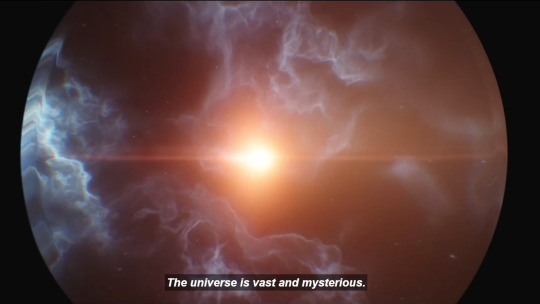
Hee Su uses it to discuss how the casual remarks from Chan Young impact him.

He uses it at the end when he decides to confess. Sure, there may be a universe where he didn't confess. And there may be a universe where he was rejected. But what if there's a universe where he's accepted. What if it's this one?

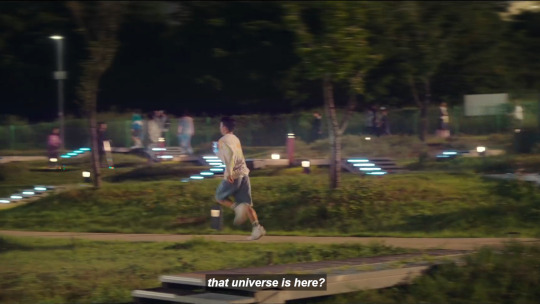
#3 - A lot of the dialogue spirals and builds
Throughout the episode, there are so many places where dialogue is building and spiraling. It's layering in so many themes and setting up the narrative so nicely that my brain is literally pinging with happiness.
We have a thread about the real value of "confessions" with multiple perspectives on that.


We have a thread about the right way to "approach" the person you care about and build a relationship.
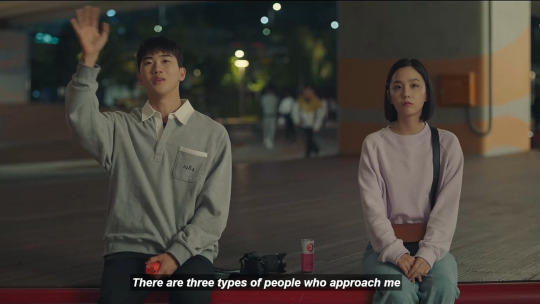


We have a thread about the unintentional things people do that can hurt others.


We have MULTIPLE pieces of dialogue that are already being used multiple times by different characters in the episode. And the callbacks are so seamlessly integrated that it works to build both meaning and narrative tension. That's a skill.

#4 - Hee Su is a dating "guru" who has never dated, but he's actually good at it.


The fact that it seems like he's mainly learned from watching television and listening to his sisters' stories is perfection. I respect that so much.


I also love this sibling relationship SO much.
#5 - What makes a "true" friend is already being explored.
See this girl? I love her. This is a fledgling friendship. But the energy is already flowing both ways. Unlike the users in his life, she learned Hee Su's name BEFORE approaching him. They're bonding over Usain Bolt and unrequited love. She's giving HIM advice even if he was supposed to be mentoring her.

See this boy? I hate him. He's the "perfect" friend. The object of Hee Su's affection. I'm probably projecting and judging him prematurely. But for this episode, I'm getting coward + popular jerk + manipulator vibes. I'll need to remind myself that he's a teenager. He might grow on me.

See this boy behind Hee Su? I'm trying to decide whether I should feel bad for him. He's obviously the brunt of his friends' jokes including Hee Su's. But there is friendly affection between the three of them, and he gives it back to them too.

#6 - I'm adopting our "Mystery" suitor.
Hee Su may be the title character, but Seung Won is who I'm adopting. Bias is in play. I've seen him before in a different show, and I LOVED his acting in it. I skipped through most of that tedious show just to get to his scenes.

But beyond the fact that he pays attention to Hee Su,


Hee Su's family is the warmth and noise in his quiet, lonely world.

#7 - There's FOOD symbolism.
We have carrot juice being given by pretty much everyone to Hee Su representing all kinds of feelings. Even if I agree with our Friend on the Fringe that it wouldn't be my choice of my drink.

And we have shared family snacks & meals

with the occasional sibling shenanigans.

I loved the ramen scene so much.
Do I have time and the energy for Episode 2 tonight? I don't know, but I just might try.
69 notes
·
View notes
Note
Hello, I love reading everything on your blog and was wondering if I could get the Bucciarati gang with a reader whose stand name is " Illusionary Heart " with her ability being able to create an invisible field that allows her track and manipulate her enemies making her the strategist Bucciarati gang.
hi, ty! and sure, i hope u enjoy and thank you for requesting <33

Giorno
He’s instantly impressed- you think in patterns, probabilities, and traps, which pairs beautifully with his own calculating nature.
You’ll be deep in a strategy meeting and Giorno will lowkey get this shiver watching you calmly explain an ambush plan, like:
“Set the trap here. He’ll step on it within four seconds, then I’ll destabilize him. Mista, you shoot at his lower limbs.”
He’s like ...Her mind is terrifying.
Loves sparring with you in private just to see how you think. Tries to out-plan you and never wins.
“Your heart guides ours,” he once whispered, holding your hand after a mission. “And I trust it.”
Bucciarati
TRUSTS YOU WITH HIS LIFE. Literally treats your word like gospel when it comes to battlefield decisions.
The way your Stand works reminds him of a heartbeat in the chest of Passione- it ties the whole crew together.
You once manipulated an enemy mid-fight to stumble into his zipper trap and he called it “divine coordination.”
He’s constantly defending you when rival Stand users call your ability “creepy” or “indirect”- he knows better. He’s seen you change the whole flow of fights.
“You’re the pulse that keeps us alive,” he told you once.
Fugo
You two are brainstorming buddies.
You’re one of the few people he can have full intellectual debates with and not lose his temper.
(Although if someone talks over you, he will go off on them.)
The logic behind your stand fascinates him- he wants to diagram it, measure the field, test variables.
Gets flustered when you tease him for being so “obsessed” with you under the guise of studying your stand.
“I’m just trying to understand its vector spread!”
Abbacchio
At first? Grumpy. Calls you a “control freak.”
After seeing you dismantle a threat without lifting a finger, he starts calling you “freakishly effective.”
Secretly impressed but won’t say it out loud- he shows respect by listening to your advice and following orders.
Will literally grumble “Fine, you were right,” after every successful tactic and stomp off to light a cigarette.
The type to walk into your room late at night like, “…Explain again how you knew that guy would fall for the bait?”
If he ever loses a teammate (even hypothetically), he always goes to you first. You’re his reassurance.
Mista
He doesn’t get all the technical stuff you explain… but he gets that you’re cool and that’s enough for him.
Constantly says “She’s got a sixth sense!” about you even when it’s clearly your stand’s ability.
Loves showing off for you in battle- “Watch this, you’ve got the plan, I got the guns!”
Gets super excited when you include him in plans like “YOU WANT ME TO SHOOT THE GUY YOU TRIP? HELL YEAH.”
Very physical. Throws his arm around you, always wants you sitting near him during team debriefs.
Narancia
Thinks you’re the coolest person alive and tells everyone.
“She’s like a ninja! She doesn’t even MOVE and the enemy falls over!”
Asks you to teach him how to “feel” the field but gets bored halfway through.
You two bond when you prank Mista using your stand- Narancia SCREAMS laughing when you make him stumble over nothing.
Gets embarrassed when you praise him for following plans right. Tries to act tough about it but his ears go red.
“You think I did good, huh? …Cool. I-I mean, yeah. I am the coolest. Heh.”
Trish
Your stand is +aesthetic soulmate energy+ to her.
She’s obsessed with how elegant it is- she says it’s like a ghost ballerina or a heartbeat that wraps around the world.
You and her develop amazing combo attacks- her using Spice Girl to soften parts of the battlefield while you trip and manipulate the enemies.
She helps you with skincare routines. You help her refine her moves.
“I like that you don’t have to shout to be powerful,” she says one day, fingers brushing yours. “You remind me I can be soft and deadly.”
She totally makes you matching outfits for when the gang goes undercover.
#jojo's bizarre adventure#bruno bucciarati x reader#bruno bucciarati#giorno giovanna x reader#giorno giovanna#fugo x reader#panacotta fugo#trish una x reader#trish una#narancia x reader#narancia ghirga#leone abbacchio x reader#leone abbacchio#mista x reader#guido mista
50 notes
·
View notes
Text
Biology of Inkfish - Splatting
“Splatting” is a severe state that all inklings can end up in due to major loss of ink. While inkfish in either of their forms can be splatted, this most often occurs in swim form or minutes within having been in swim form previously. During transformation into swim form, the skin lets more ink through, which makes the introduction of foreign liquids extremely non-ideal. During splatting, enough foreign liquid enters the system for the ink system to forcibly eject most, if not all, of the ink in the body as a response to unidentified ink. This happens when the ink hearts* all contract in unison to try to replace unfamiliar substances in the ink stream, or as an extreme response to a threat. Ink is sprayed out from all ink ducts in an explosive manner, which may deter an attacking predator and clear out the ink system, but which also leaves the inkfish stranded on the ground.
*The ink hearts are minor organs situated at different points of the ink vein network, and are responsible for cycling and ejecting ink.
Inklings have extremely stretchy skin, as well as specialized muscle structures that keep their shape and strengthen when ink is coursed through them. Thus, when ink flow is redirected or reduced, these muscles shrink and flatten - when ink is removed from the muscles and the body, smaller inkfish can lose more than 50% of their total body weight. In inkfish, this adaptation is useful as the shape of the body and even the consistency can be greatly altered. However, it comes with the downside that an inkling that has lost most or all of its ink will struggle to move quickly and may be unable to escape from predators until enough ink is recovered, which may take minutes without outside help. To adapt, inkfish have also improvised a way to utilize their significantly lighter bodies and use the propulsion organ inside their heads to use the remaining bits of their ink to launch into the air and fill the organ with air to attempt to float to safety.
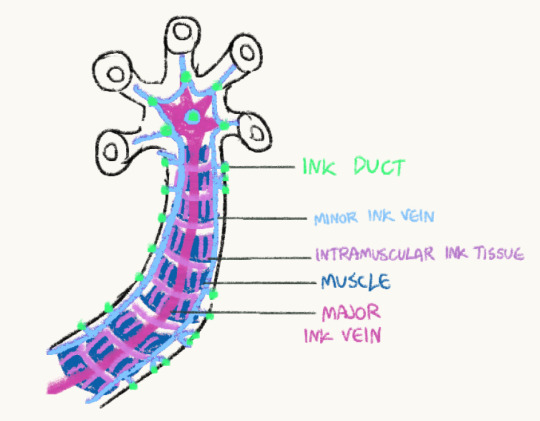
[A diagram of an inkling's basic ink layers. The major ink veins run across the body, pumping ink from the ink sac and splitting into hundreds of minor ink veins. Minor ink veins transport ink to the ink-holding tissue within muscles as well as the ink ducts, which bleed out ink through the skin. When these ink ducts are open, the flow of ink between the skin and the body is high.]
Splatting is a key element in some aspects of inkling culture, like Turf Wars and other extreme sports. In Turf Wars, enemy ink of another consistency will cause a rejection of all the circulating ink in an inkfish’s body in large amounts. A more controlled form of splatting can also occur as a defensive mechanism from extreme agitation, and is used in some attacks, such as the Kraken spin and especially Splashdown. These splatters are typically sustainable for users during Special states due to the high amount of ink that is being produced. Being in contact with other people's ink is known to boost ink production as a whole.
Splatting looks very violent to other species, but it is mostly harmless to inkfish with normal bodily functions. Inkfish in a safe environment will regenerate from splatting on their own given enough time to regain their ink, and splatting can be immediately treated if replacement ink is introduced. Splatted inkfish will absorb ink from their environment and replenish their bodies in a matter of seconds. The only common situation in which splatting is irrecoverable is in situations where the body is engulfed in water, in which case water being absorbed through the skin will flush the ink from the body and prevent recovery. This makes inkfish ill-fitted for being in the water, though they can use their air sacs to float on top of the surface, and attempt to swim or jet propel themselves onto land.
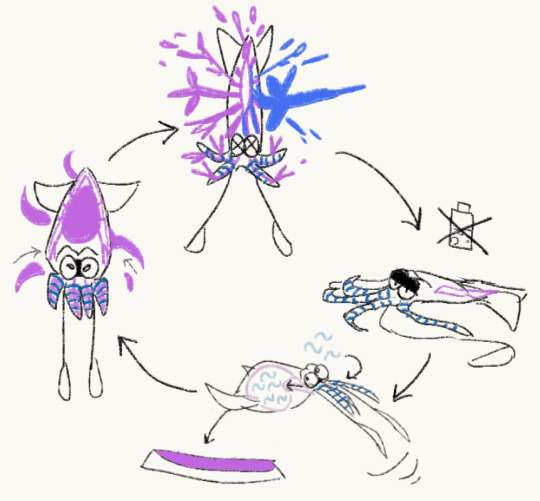
[An example showing the processes of the body when inkfish are splatted. The body rejects ink of the wrong color by forcefully ejecting all the ink in the ink sac and system, leaving the body in a low-ink "splatted" state. Inkfish are able to draw air into their mantles to utilize their reduced body weight and jet propulsion abilities to fly to an area where ink can be absorbed back into the body, which is a fast process.]
44 notes
·
View notes
Note
Would love to see the diagrams connecting your headlights to your Sonas.
Honestly even just explaining the headlights kinda makes the "Xko is everyone and everyone is Xko and it blends together sometimes." make more sense
aaa thank you! I appreciate you saying that, sometimes I feel like the more info I give the less it makes sense on the outside, ykno?
each sona I depict is an abstraction that appeals to specific headlights I have, usually a blend of them. there are other sonas like derivative self-inserts and fandom stuff, but I only made diagrams for the main 5 I depict the most often (explanations below the cut!!)
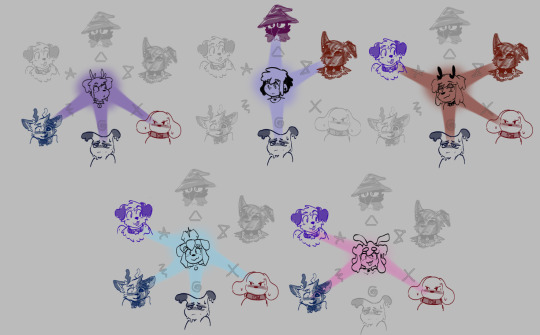
puddle is flow + moth, also representative of daze because I'd use puddle for 'reflection'/vent art for a long time. also includes daze because puddle gets so very very tired lol, I always depicted puddle having my physical body pains despite them being made of slime?? LMAO
pudko/'werewolf puddle' is moth + pup + daze/red highly reactive + hyper-aware of body pains & super foggy ... I don't draw pudko much these days... I should draw them more... 💭
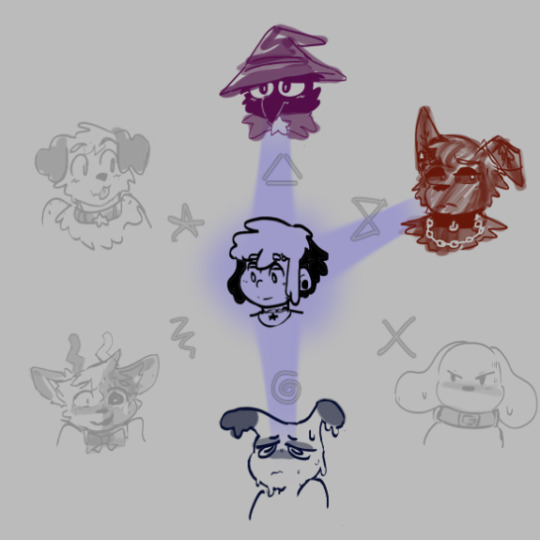
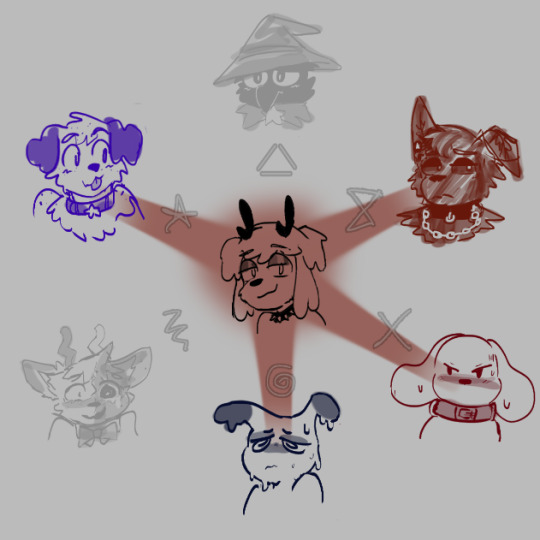
xko is pup + fawn (bubbling over with awe/wonder) with red's high reactivity. feels no pain or fear!!!!!!
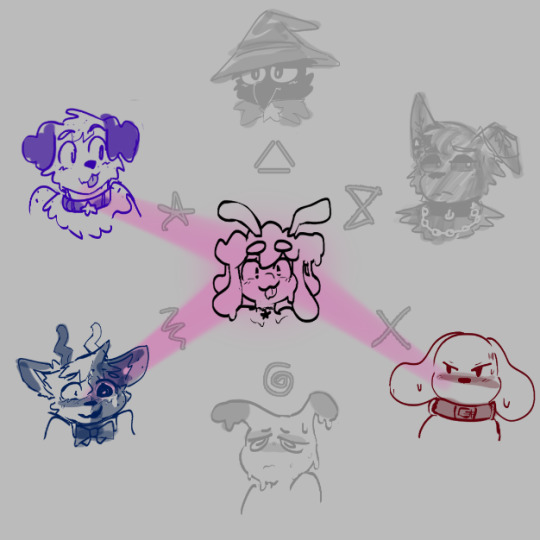
the next two are very similar!! neither of them remember they are part of xko, while the previously mentioned sonas are always aware of xko as their 'core'
roboko is pup + fawn + daze/red
easily flustered + foggy, more likely to vibe/coast through stuff or experience half-awareness, switching to excitability/pup brain to coast
(technically I have an in-universe reason why roboko and xko are linked via flux but it's convoluted/lewd and an unnecessary detail for this ask lmao if you're curious it's briefly mentioned in the roboko user forums)
flux is fawn + red/daze
similar, easily flustered + foggy but fully present through difficult circumstances
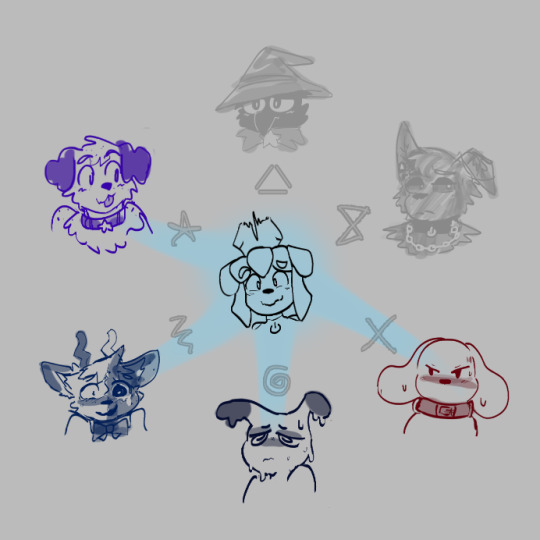
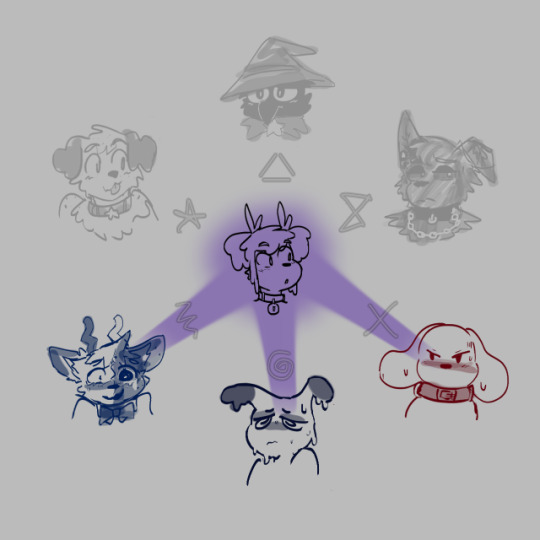
as I mentioned before, daze and red are typically together or feel like they're part of 'the same self' so the order of daze/red or red/daze in these has a difference to me lol;; it's so weird how little details feel like a big deal! I put them all together in a big image canvas (at the start of this post), and the LOCATIONS of the diagrams together felt like they had a right and wrong place.
17 notes
·
View notes
Text

Week 6
Good day everyone!!
Today, we started with an icebreaker game called "Rebus Puzzle," where we had to guess the meaning of pictures, some of which included clues and underscores to help us figure them out. After the game, we discussed different types of diagrams, including Activity Diagrams, Use Case Diagrams, ERD Diagrams, Data Flow Diagrams, and more. We also did an activity that challenged our creativity by designing and fixing images to make them look as they should. This really spark up our mind on how we should portray our UI in a user friendly manner.
3 notes
·
View notes
Text
Open Platform For Enterprise AI Avatar Chatbot Creation

How may an AI avatar chatbot be created using the Open Platform For Enterprise AI framework?
I. Flow Diagram
The graph displays the application’s overall flow. The Open Platform For Enterprise AI GenAIExamples repository’s “Avatar Chatbot” serves as the code sample. The “AvatarChatbot” megaservice, the application’s central component, is highlighted in the flowchart diagram. Four distinct microservices Automatic Speech Recognition (ASR), Large Language Model (LLM), Text-to-Speech (TTS), and Animation are coordinated by the megaservice and linked into a Directed Acyclic Graph (DAG).
Every microservice manages a specific avatar chatbot function. For instance:
Software for voice recognition that translates spoken words into text is called Automatic Speech Recognition (ASR).
By comprehending the user’s query, the Large Language Model (LLM) analyzes the transcribed text from ASR and produces the relevant text response.
The text response produced by the LLM is converted into audible speech by a text-to-speech (TTS) service.
The animation service makes sure that the lip movements of the avatar figure correspond with the synchronized speech by combining the audio response from TTS with the user-defined AI avatar picture or video. After then, a video of the avatar conversing with the user is produced.
An audio question and a visual input of an image or video are among the user inputs. A face-animated avatar video is the result. By hearing the audible response and observing the chatbot’s natural speech, users will be able to receive input from the avatar chatbot that is nearly real-time.
Create the “Animation” microservice in the GenAIComps repository
We would need to register a new microservice, such “Animation,” under comps/animation in order to add it:
Register the microservice
@register_microservice( name=”opea_service@animation”, service_type=ServiceType.ANIMATION, endpoint=”/v1/animation”, host=”0.0.0.0″, port=9066, input_datatype=Base64ByteStrDoc, output_datatype=VideoPath, ) @register_statistics(names=[“opea_service@animation”])
It specify the callback function that will be used when this microservice is run following the registration procedure. The “animate” function, which accepts a “Base64ByteStrDoc” object as input audio and creates a “VideoPath” object with the path to the generated avatar video, will be used in the “Animation” case. It send an API request to the “wav2lip” FastAPI’s endpoint from “animation.py” and retrieve the response in JSON format.
Remember to import it in comps/init.py and add the “Base64ByteStrDoc” and “VideoPath” classes in comps/cores/proto/docarray.py!
This link contains the code for the “wav2lip” server API. Incoming audio Base64Str and user-specified avatar picture or video are processed by the post function of this FastAPI, which then outputs an animated video and returns its path.
The functional block for its microservice is created with the aid of the aforementioned procedures. It must create a Dockerfile for the “wav2lip” server API and another for “Animation” to enable the user to launch the “Animation” microservice and build the required dependencies. For instance, the Dockerfile.intel_hpu begins with the PyTorch* installer Docker image for Intel Gaudi and concludes with the execution of a bash script called “entrypoint.”
Create the “AvatarChatbot” Megaservice in GenAIExamples
The megaservice class AvatarChatbotService will be defined initially in the Python file “AvatarChatbot/docker/avatarchatbot.py.” Add “asr,” “llm,” “tts,” and “animation” microservices as nodes in a Directed Acyclic Graph (DAG) using the megaservice orchestrator’s “add” function in the “add_remote_service” function. Then, use the flow_to function to join the edges.
Specify megaservice’s gateway
An interface through which users can access the Megaservice is called a gateway. The Python file GenAIComps/comps/cores/mega/gateway.py contains the definition of the AvatarChatbotGateway class. The host, port, endpoint, input and output datatypes, and megaservice orchestrator are all contained in the AvatarChatbotGateway. Additionally, it provides a handle_request function that plans to send the first microservice the initial input together with parameters and gathers the response from the last microservice.
In order for users to quickly build the AvatarChatbot backend Docker image and launch the “AvatarChatbot” examples, we must lastly create a Dockerfile. Scripts to install required GenAI dependencies and components are included in the Dockerfile.
II. Face Animation Models and Lip Synchronization
GFPGAN + Wav2Lip
A state-of-the-art lip-synchronization method that uses deep learning to precisely match audio and video is Wav2Lip. Included in Wav2Lip are:
A skilled lip-sync discriminator that has been trained and can accurately identify sync in actual videos
A modified LipGAN model to produce a frame-by-frame talking face video
An expert lip-sync discriminator is trained using the LRS2 dataset as part of the pretraining phase. To determine the likelihood that the input video-audio pair is in sync, the lip-sync expert is pre-trained.
A LipGAN-like architecture is employed during Wav2Lip training. A face decoder, a visual encoder, and a speech encoder are all included in the generator. Convolutional layer stacks make up all three. Convolutional blocks also serve as the discriminator. The modified LipGAN is taught similarly to previous GANs: the discriminator is trained to discriminate between frames produced by the generator and the ground-truth frames, and the generator is trained to minimize the adversarial loss depending on the discriminator’s score. In total, a weighted sum of the following loss components is minimized in order to train the generator:
A loss of L1 reconstruction between the ground-truth and produced frames
A breach of synchronization between the lip-sync expert’s input audio and the output video frames
Depending on the discriminator score, an adversarial loss between the generated and ground-truth frames
After inference, it provide the audio speech from the previous TTS block and the video frames with the avatar figure to the Wav2Lip model. The avatar speaks the speech in a lip-synced video that is produced by the trained Wav2Lip model.
Lip synchronization is present in the Wav2Lip-generated movie, although the resolution around the mouth region is reduced. To enhance the face quality in the produced video frames, it might optionally add a GFPGAN model after Wav2Lip. The GFPGAN model uses face restoration to predict a high-quality image from an input facial image that has unknown deterioration. A pretrained face GAN (like Style-GAN2) is used as a prior in this U-Net degradation removal module. A more vibrant and lifelike avatar representation results from prettraining the GFPGAN model to recover high-quality facial information in its output frames.
SadTalker
It provides another cutting-edge model option for facial animation in addition to Wav2Lip. The 3D motion coefficients (head, stance, and expression) of a 3D Morphable Model (3DMM) are produced from audio by SadTalker, a stylized audio-driven talking-head video creation tool. The input image is then sent through a 3D-aware face renderer using these coefficients, which are mapped to 3D key points. A lifelike talking head video is the result.
Intel made it possible to use the Wav2Lip model on Intel Gaudi Al accelerators and the SadTalker and Wav2Lip models on Intel Xeon Scalable processors.
Read more on Govindhtech.com
#AIavatar#OPE#Chatbot#microservice#LLM#GenAI#API#News#Technews#Technology#TechnologyNews#Technologytrends#govindhtech
3 notes
·
View notes
Text
Decoding Complexity: Mastering UML with Expert Guidance

Welcome to the realm of UML, where abstract ideas meet concrete solutions, and the language of diagrams speaks volumes. At DatabaseHomeworkHelp.com, we understand the challenges that come with UML assignments, and our experts are here to guide you through even the toughest topics. In this blog, we'll explore a complex UML topic, provide master-level sample questions and answers, and demonstrate how our experts can provide the assistance you need. If you find yourself saying, "Help with UML homework," you've come to the right place.
Topic: "Dynamic Modeling with Sequence Diagrams in UML"
Dynamic modeling in UML, specifically through sequence diagrams, offers a powerful way to visualize the interactions and flow of messages between objects in a system. Let's delve into some master-level sample questions and answers to showcase the depth of this topic.
Sample Questions:
1. Design a sequence diagram for an online shopping system where a user adds items to the cart, proceeds to checkout, and completes the purchase. Highlight user interactions and system responses.
Answer:
uml
@startuml actor User participant Cart participant Checkout participant Payment User -> Cart: Add items to cart activate Cart Cart -> Checkout: Proceed to checkout activate Checkout Checkout -> Payment: Complete purchase activate Payment Payment --> Checkout: Confirmation deactivate Payment Checkout --> Cart: Confirmation deactivate Checkout Cart --> User: Order confirmation deactivate Cart @enduml
2. Implement a Java code snippet for a class involved in the sequence diagram above, demonstrating the handling of cart operations.
Answer:
java
public class ShoppingCart { private List<Item> items = new ArrayList<>(); public void addItem(Item item) { items.add(item); } public List<Item> getItems() { return items; } // Other relevant methods... }
3. Explain the use of asynchronous messages in a sequence diagram and provide an example scenario where they are beneficial.
Answer: Asynchronous messages in UML sequence diagrams represent interactions where the sender does not need to wait for a response. For example, in a messaging system, a user might send a message to another user without waiting for an immediate reply. This non-blocking communication allows for increased system responsiveness and efficiency.
How Our Experts Can Help:
At DatabaseHomeworkHelp.com, our expert team consists of seasoned professionals with extensive experience in UML and dynamic modeling. When you seek help with UML homework, you benefit from:
Expertise in UML: Our team is well-versed in UML concepts, ensuring accurate and comprehensive assistance.
Customized Solutions: We tailor our solutions to your specific requirements, ensuring that your UML assignments meet the highest standards.
Code Proficiency: Our experts are not only adept at creating diagrams but are also skilled in implementing code, bridging the gap between UML and practical application.
Timely Delivery: We understand the importance of deadlines, and our experts work diligently to deliver solutions promptly.
Dynamic modeling with sequence diagrams is undoubtedly a challenging aspect of UML, but with the right guidance, it becomes a manageable task. At DatabaseHomeworkHelp.com, we pride ourselves on offering top-notch assistance for UML assignments. If you find yourself struggling with dynamic modeling or any other UML concept, simply say, "Help with UML homework," and let our experts guide you to success.
8 notes
·
View notes
Text
TIP #1
If you fear you've forgotten items departing somewhere here is a #LifeHack
Save your packing list for use as a checklist. This can calm your fears of left-behind belongings.
TIP #2
Have a to-do list but have difficulty with time and priority?
Making your list into a flowchart helps with sequencing and reduces aimlessness, overwhelm, and decision-making.
BONEUS TIP! #3
For carabiner users, an alligator clip is the perfect partner for your aforementioned flow diagram!
You may also keep a 'Neopet' close to the hip.
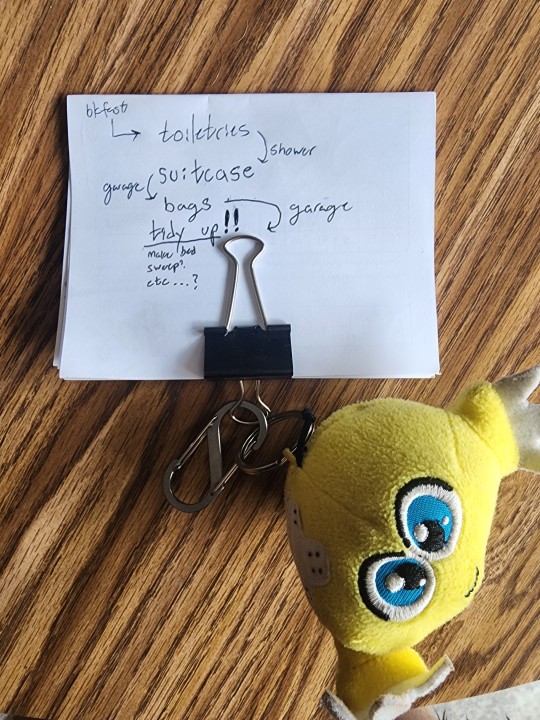
14 notes
·
View notes
Text
7 QUALITY CONTROL TOOLS FOR PROCESS IMPROVEMENT

“As much as 95 per cent of all quality-related problems in the factory can be solved with seven fundamental quantitative tools.”
-Kaoru Ishikawa, The inventor of Fishbone Diagram
In today’s customer-centric market, quality is an integral factor in the growth and sustainability of any business. Businesses go the extra mile to provide the best and excellent customer experience to ensure customer satisfaction. Hence, efficient quality management which has the highest impact on customer experience is one of the most essential features for any business.
Introduced by Kaoru Ishikawa, the seven basic tools of quality also known as 7QC tools are very effective in quality management and quality assurance process. So, businesses who want to ensure competitive and excellent quality of their products and services can utilize the proven 7QC tools for structuring a strategic plan for quality improvement.
LIST OF 7 QC TOOLS
Cause and Effect Diagram
Cause and Effect Diagram also known as Fishbone Diagram helps in identifying the potential causes of an effect or a problem. In addition to sorting ideas in respective categories, it also helps in understanding the areas of opportunity through effective brainstorming. Fishbone training empowers you to identify the potential cause in the problem.
Control Chart
Control charts are used to study how the processes have changed over a period of time. Further, by comparing current data to historical control limits, one could lead to the conclusion about whether the process variation is consistent as in under control or unpredictable as in out of the control due to being affected by special causes of variation.
Pareto Chart
Pareto Chart is based on the 80/20 rule where it shows the significant factors that have the highest impact on the identified problem.
Check Sheet
Check sheet is a structured process which helps to collect and analyzing data. It is an effective tool that can be for a variety of purposes.
Histogram
Histogram is commonly used a graph that shows the data and its frequency of distribution to help users identify each different value in a set of data occurs.
Scatter Diagram
Scatter diagram shows the relationship between two important factors i.e. pairs of numerical data, one variable on each axis to demonstrate the relationship.
Stratification
Stratification also known as a flow chart or run chart is a technique that separates the data gathered from a variety of sources so that patterns can be seen i.e., the path an entity has taken through a defined process.
Utilizing the 7 QC tools in six sigma or quality management process helps in taking a systematic approach to identify and understand the risk, assess the risk, control fluctuation of product quality and accordingly provide solutions to avoid future defects.
WHEN SHOULD YOU USE 7 QC TOOLS?
7 QC tools can be carried out during the quality management, quality improvement process, six sigma implementation processes or even the regular PDCA cycle for the quality purpose for enhanced quality management.
In the first phase of measuring and identifying, Fishbone Diagram also known as cause and effect diagram, Pareto Chart and Control Chart can be utilized. In the next phases of assessment and analysis, Scatter Diagram, Histogram and Checklist can be carried out. The Control Chart can be utilized consistent quality improvement.
BENEFITS OF 7 QC TOOLS
The 7 QC tools are structured and fundamental instruments that help businesses improve their management and production process for achieving enhanced product quality.
From assessing and examining the production process, identification of key challenges and problems to controlling the fluctuation present in the product quality and providing solutions for prevention of defects in future, the easy to understand and implement, 7 QC tools are very effective. Some of the major business benefits of 7 QC tools are listed below.
Provides a more structured path for problem-solving and quality improvement
Easy to understand as well as implement yet extremely effective
A scientific and logical approach for problem-solving
Follows the 80/20 rule i.e. gain 80% result with 20% efforts
Improve the quality of product and services
Helps in identifying and analyzing problems during the process
Fishbone training aides in root cause analysis and problem-solving
Encourages team spirit and fosters a healthy culture
Identifies roots cause and solve it permanently
Enhance customer experience and customer satisfaction
Based on the data-driven process and customer-centric approach, 7 QC tools implementation is one of the most effective processes that too in the shortest amount of time.
4C team of certified professionals has provided 80+ implementation of 7 QC Tools and 120+ 7 QC Tools Training. By solving 200+ quality problems, 4C has empowered clients to reduce the 80% cost of poor quality. To accelerate your quality management process and reduce your cost of poor quality, contact our experts now.
#iso certification#iso certification consultants#iso consultancy#iso consultant#iso certificate online#iso certification in india
3 notes
·
View notes
Text
[image id: a flow diagram showing the cycle of how a tumblr user uses tumblr. The diagram consists of arrows and intercepting labels going in a continuous clockwise circle, indicating a never ending cycle.
Moving clockwise the labels are as follows: “I go on tumblr” // “I reblog two hundred shitposts” // “mutuals reblog my posts, affirming I am loved” // “I exit tumblr”
end id]
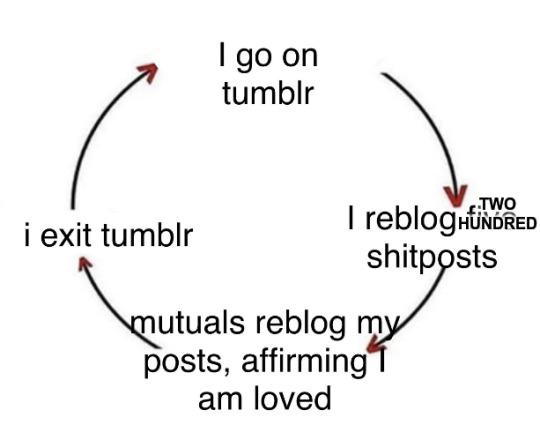
#1. when I was looking for an id in the notes I found the alphabet completionist reblog and could not resist using that as my base because#that blog is my error and therefore I very much will interact with it when I can#2. I’m sorry if the id is messy I was trying to make it make sense on top of giving eye to screen descriptions#3. I do not reblog two hundred DIFFERENT shitposts. I reblog maybe 2 different ones. one I just reblog 199 times lmao#my mutuals know this and bear with me 😫I love them <3#LMAOOOO edit * the alphabet completionist blog is my HERO! not my error🫡
125K notes
·
View notes
Text
From Concept to Code: Final Year PHP Projects with Reports for Smart Submissions
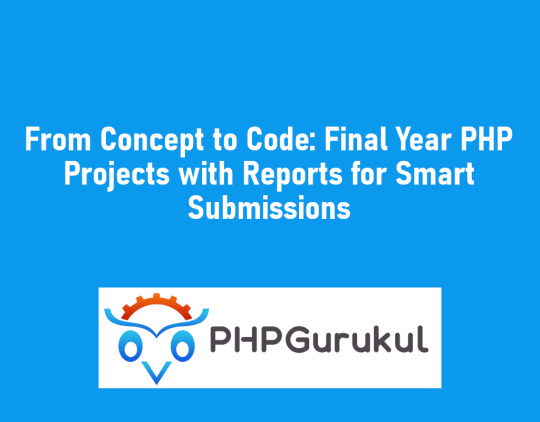
At PHPGurukul, we know the importance of your final year project — both as an assignment, but also as a genuine portrayal of your technical expertise, your comprehension of real-world systems, and your potential to transform an idea into a viable solution.
Each year, there are thousands of students who come to our site in search of a PHP project for final year students with report — and we’re happy to assist them by providing fully operational PHP projects with source code, databases, and professionally documented code. Whether you’re studying B.Tech, BCA, MCA, or M.Sc. (IT), our projects assist you in achieving academic requirements as well as preparing for job interviews and practical software development in the future.
Click here: https://phpgurukul.com/from-concept-to-code-final-year-php-projects-with-reports-for-smart-submissions/
Why PHP for your Final Year Project?
PHP is one of the most popular server-side scripting languages on the web development scene. It’s open-source, is compatible with MySQL, and runs almost 80% of websites on the world wide web.
How is this relevant to students?
PHP is a great language upon which to develop dynamic web applications. You can use PHP to build login systems, e-commerce sites, content management sites, and medical or educational portals.
We at PHPGurukul offer free PHP projects for students in every major discipline — each one designed, documented, and waiting to be improved. They are meant not only to submit, but to learn, develop, and innovate.
PHP Projects Are Ideas in Action
We think that PHP projects are concepts waiting to happen. All projects begin with a notion — such as handling hospital data, automating test results, or running appointments — and conclude with a tidy, user-friendly app.
And that’s what your final year project should be: an idea made real with clarity, creativity, and code.
What Makes PHPGurukul Projects Special?
All our PHP projects for final year students with report are accompanied with:
1. Clean and Well-Commented Full Source Code
2. SQL Database File
3. Setup Instructions
4. Project Report (abstract, modules, technology used, screenshots)
5. Customization Guidance
Our projects are simple to download, test, and execute on XAMPP or WAMP environments. You don’t have to be an expert — let us assist you in growing from basic PHP to full-fledged application development.
More projects here: PHP Projects Free Downloads
What Should a Good PHP Project Report Contain?
The project report is equally significant as the code. That is why we offer meticulous documentation with every project that is substantial. A typical final-year project report of PHPGurukul contains:
1. Project abstract
2. Project modules and explanation
3. Technologies and tools utilized
4. Database schema
5. Data Flow Diagrams (DFD)
6. Screenshots of all the modules
7. Conclusion and future scope
You can accept our reports as is or edit them according to your college standards. We help you spend more time learning and less time formatting!
How to Stand Out Your Project?
Here are 4 easy tips to incorporate uniqueness into your PHPGurukul project:
1. Increase It — Include one or two features such as email integration, PDF export, or analytics.
2. Personalize the UI — Redo the interface using Bootstrap and make it contemporary.
3. Know Your Code — Learn how each module functions prior to your viva.
4. Practice Demo — Be prepared to demonstrate and articulate your system flow during presentations.
Your last year is a turning point. With our all-inclusive packages of code + database + report, you can concentrate on constructing, personalizing, and learning. So don’t worry about deadlines or documentation — download, learn, and create something you’re proud of.
Browse our PHP Projects with Source Code and Reports and begin your journey towards mastering PHP and web development.
PHP Gurukul
Welcome to PHPGurukul. We are a web development team striving our best to provide you with an unusual experience with PHP. Some technologies never fade, and PHP is one of them. From the time it has been introduced, the demand for PHP Projects and PHP developers is growing since 1994. We are here to make your PHP journey more exciting and useful.
Email: [email protected] Website : https://phpgurukul.com
0 notes
Text
3D Map Illustration for Campus Planning: A New Approach to Architecture Illustration
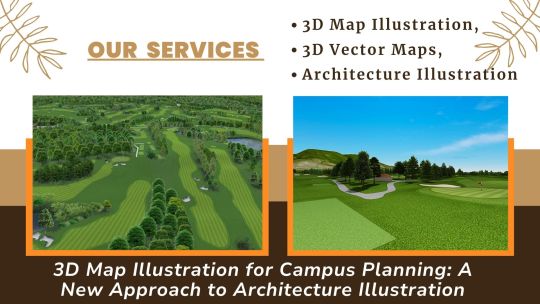
New Approach to Architecture Illustration
In an age where visual communication plays a critical role in architecture and urban design, 3D Map Illustration has emerged as a powerful tool for conveying complex spatial information with clarity and appeal. Especially in campus planning, where a multitude of buildings, roads, landscapes, and amenities must coexist in harmony, 3D Vector Maps offer an interactive and intuitive way to guide decision-making, facilitate stakeholder engagement, and enhance design outcomes.
This blog explores how 3D map illustration is reshaping the field of Architecture Illustration, particularly in educational, medical, and corporate campus planning, and why it's becoming the new standard for professionals seeking precision and creativity.
The Evolution of Campus Planning Visualization
Traditionally, campus master plans have relied on 2D CAD drawings, blueprints, and static illustrations to communicate spatial intent. While accurate, these tools often fail to convey depth, scale, and real-world context, especially to non-technical stakeholders such as investors, students, faculty, or administrative staff.
3D map illustration bridges this communication gap. By transforming top-down layouts into realistic and immersive visuals, 3D Vector Maps provide an aerial perspective that’s easy to understand and visually engaging. Whether it's a new university expansion, a hospital redevelopment, or a tech park layout, this modern approach enables planners and architects to better explain complex ideas, simulate pedestrian or vehicle flows, and visualize architectural harmony between existing and proposed structures.
What is a 3D Map Illustration?
A 3D map illustration is a digitally rendered visual representation of geographical or architectural space that includes height, depth, and texture. Unlike traditional 2D diagrams, 3D maps offer perspective, elevation, and realism, providing viewers with a more intuitive sense of space and navigation.
In campus planning, 3D illustrations can include buildings, pathways, roads, green spaces, water bodies, and even signage or furniture. Using 3D Vector Maps, architects and urban designers can manipulate elements with scalability and precision, ensuring the accuracy of every object relative to the surrounding environment.
Why 3D Vector Maps are Ideal for Campus Planning
Here are some compelling reasons why they are ideal for campus planning:
1. Accurate Spatial Representation
3D vector data allows for the precise placement and scaling of objects. This ensures that each building, pathway, or landscape element is represented in proportion, which is vital for architectural planning and future expansion.
2. Enhanced Stakeholder Communication
Stakeholders can quickly grasp the master plan without needing to interpret technical blueprints. A 3D map illustration can turn a complex plan into a digestible, engaging visual that supports better discussions and faster approvals.
3. Simulation of Real-World Scenarios
Want to test emergency evacuation routes?
4. Seamless Integration with AR and VR
Modern Architecture Illustration is moving beyond the screen into immersive experiences. 3D Vector Maps can be integrated into Augmented Reality (AR) or Virtual Reality (VR) systems, allowing users to walk through a campus in real-time, before construction even begins.
Applications of 3D Map Illustration in Campus Planning
Let’s take a closer look at the various ways 3D Map Illustration is applied in different campus settings.
● University and Educational Campuses
In higher education, where institutions continuously expand with new departments, hostels, libraries, and recreational areas, a 3D map illustration helps in comprehensive master planning. It allows planners to design for long-term growth, manage space utilization effectively, and even create interactive maps for student orientation.
● Healthcare and Hospital Campuses
Hospitals are complex environments with critical zones such as emergency wards, operating theaters, and research facilities. 3D Vector Maps allow architects to model accessibility, optimize patient and staff movement, and ensure compliance with healthcare planning standards.
● Corporate and Tech Campuses
Global tech giants invest heavily in campus design to reflect brand identity, sustainability goals, and employee wellness. A 3D map illustration helps visualize these elements—integrating outdoor collaborative spaces, green areas, and smart infrastructure into one cohesive visual.
● Government and Civic Infrastructure
For civic institutions, such as police training academies or government R&D centers, 3D Vector Maps support spatial analysis for security, zoning, and logistics.
The Process Behind Creating a 3D Map Illustration
Creating a 3D map illustration for campus planning involves several technical and creative stages:
1. Data Collection
This includes gathering satellite imagery, topographical maps, CAD drawings, and GIS data. For accuracy, architects often integrate drone-based photogrammetry and LiDAR scans.
2. 3D Modeling
Using tools like SketchUp, Blender, Rhino, or AutoCAD, base models are created for each structure. Elements such as building height, textures, and terrain features are modeled in detail.
3. Vectorization
The models are converted into 3D Vector Maps, where every component is scalable, editable, and can be layered for analysis. Vector maps allow for faster updates and seamless integration into GIS or BIM platforms.
4. Rendering and Styling
Depending on the visual goal, the map is rendered in a particular style—photorealistic, stylized, isometric, or color-coded—to highlight specific functions such as zones, access points, or pedestrian pathways.
5. Integration and Presentation
Finally, the 3D illustration is delivered in formats suitable for interactive presentations, web-based platforms, or immersive AR/VR walkthroughs.
Benefits for Architects and Urban Designers
Incorporating 3D Map Illustration into campus planning is more than just a visual upgrade—it’s a strategic move for success:
Faster Client Approvals: Clear and immersive visuals reduce client confusion and speed up decision-making.
Better Planning Accuracy: Scale-accurate maps reduce errors in land-use assumptions.
Improved Marketing: Rendered 3D maps are excellent marketing tools for student recruitment, donor presentations, or public exhibitions.
The Future of Architecture Illustration is 3D
As technologies like BIM (Building Information Modeling), smart campuses, and digital twins continue to evolve, 3D Map Illustration will play a central role in architectural visualization. What once required hours of explanation in stakeholder meetings can now be communicated in minutes through an interactive 3D Vector Map.
With user expectations growing and the need for smarter cities and campuses on the rise, the blend of art, data, and design through Architecture Illustration is not just a trend—it’s a necessity. Forward-thinking architecture firms and campus planners who adopt 3D map illustration are better equipped to innovate, communicate, and build spaces that truly work for people.
Final Thoughts
3D Map Illustration has transformed the way we approach campus planning, offering a versatile and compelling way to visualize complex environments. With the precision of 3D Vector Maps and the storytelling power of Architecture Illustration, planners can now craft smarter, more engaging, and highly functional campuses for the future.
Whether you're an architect, urban designer, or educational institution, embracing this new visual language isn’t just an option—it’s the way forward.
0 notes
Text
Fun Fact: this phenomenon is described by an energy load diagram know as the Duck Curve, as observed on the Californian energy grid.

(image credit Energy.gov)
This curve describes power loading on the electrical grid during a high-solar-energy, low-solar-power day (a typical day in California for example). As seen, the load reaches its lowest point at approximately 1-2 PM, which is peek solar hours - at this point certain electrical providers will actually drop their price per kilowatt hour to encourage people to use power less their infrastructure be damaged. then at approximately 5-8 PM the energy consumption MASSIVELY increases - this is when people go home for the day, turn on their AC, stove, and whatnot, just as solar power is waning, causing the large overloading ramp.
This curve tells us a few things:
Prime time to consume power in high-solar areas is at peak solar, avoid consuming power later on if possible (an individual person won't contribute overmuch to this, but the load increase has been proven to come from the residential power sector as a whole).
Practical energy storage solutions must be implemented alongside solar generation else this effect will only get worse and worse - the average Californian grid engineer is a nervous wreak over this since its only a matter of time before the whole grid goes down because of it. Practical methods include pumped hydro (not great in drought areas, but an effective bulk storage method), flywheel storage, and MAYBE batteries (specifically redux-flow batteries - shipping-container sized batteries that may not store a lot of energy, but they are safer more ecologically viable than lithium ion)
Failing energy storage solutions, other forms of power need to be implemented alongside solar - solar is what is known as a non-dispatchable energy source - meaning that its power output can't (generally) be user-adjusted - so however much power it creates is put on the grid (other forms of non-dispatchable power include wind and some wave energy). To "smooth" the duck curve, solar installations could be replaced with either dispatchable power (hydropower, any steam-turbine based reactor, geothermal, etc) or dispatchable power that operates at different peak hours.
A final option is to implement variable loads - mass loads that turn on during solar peak hours and are off at other times. This is less than ideal since it doesn't really solve the issue, just hides it, but it does mean more consistent loading that hopefully the CAISO (California independent system operator) will interpret as greater demand for more redundant lines. Practical uses for this energy include desalinization plants, electrolysis for hydrogen fuel production, or a big siren that blares "California is experiencing technical difficulties, please stand by"
No one in California knows what a Duck looks like, considering this term dates back to 2012, and that grey line ain't look nothing like a duck.

73K notes
·
View notes
Text
What Makes a Good EV Charging Station Site Plan? AmperEVcharging Explains
As electric vehicles (EVs) become increasingly popular, the need for reliable and efficient EV charging infrastructure grows alongside them. Whether it's a small public charging spot or a large commercial installation, every project begins with a solid foundation: the EV charging station site plan.
At AmperEVcharging, we understand how crucial this early planning phase is. A good site plan ensures smooth permitting, efficient utility approvals, and an overall safe, scalable, and user-friendly charging station. But what exactly makes a site plan effective? Let's dive into the key elements that define an excellent EV charging station site plan and how AmperEVcharging brings it all together.
1. Strategic Location Selection
It all starts with location. A well-chosen site not only boosts visibility and convenience but also plays a significant role in determining the type of equipment, power availability, and permitting requirements.
When planning the location, AmperEVcharging focuses on:
Accessibility: Ensuring that vehicles can easily access the charging station without congestion.
Power Supply Proximity: Shorter distances to existing electrical infrastructure can lower installation costs.
User Needs: Choosing spots near shopping centers, office parks, or highways to maximize usability.
By identifying key traffic patterns and utility assets early, our team helps avoid costly adjustments down the line.
2. Efficient EV Charging Infrastructure Design
A good site plan doesn't just outline where the chargers go. It must consider the bigger picture: power capacity, equipment types, future expansion, and user flow.
AmperEVcharging specializes in EV charging infrastructure design that is both smart and scalable. We focus on:
Load management for high-demand sites
Space planning for both Level 2 and DC fast chargers
Expansion readiness with modular design techniques
Parking integration for maximum convenience
Whether you're deploying a few stations or building a full EV charging hub, our infrastructure designs ensure that your system is future-ready and efficient.
3. Technical Equipment Planning: Level 2 & DC Fast Chargers
Choosing the right charging equipment is a big part of your site plan's success. Not all chargers are created equal, and different environments require different solutions.
Our experts at AmperEVcharging understand the nuances between:
Level 2 EV charger design: Ideal for workplaces, commercial centers, and residential buildings. These provide a moderate charging speed, perfect for longer dwell times.
DC fast charger engineering: Best suited for highway corridors or high-traffic urban areas where users need a quick charge.
Each charger has unique electrical, spatial, and cooling requirements. A well-thought-out plan accounts for all of this while aligning with user expectations and local infrastructure.
4. EV Charging Permit Drawings
Before construction can begin, a thorough set of permit drawings is required. These drawings serve as the formal blueprint that communicates every detail to the authorities having jurisdiction (AHJ).
Our team at AmperEVcharging prepares EV charging permit drawings that are clear, detailed, and compliant with local codes. These typically include:
Site layout with charger positions and parking
Electrical one-line diagrams
Trenching and conduit plans
Signage and accessibility features
Getting this part right not only helps avoid project delays but also smoothens the process of getting approvals.
5. AHJ Permitting for EV Stations
Dealing with local permitting authorities can be a complex task, especially since every city or county has its own regulations.
AmperEVcharging takes the hassle out of AHJ permitting for EV stations by handling:
Application submissions
Communication with code officials
Revisions and compliance adjustments
Building and electrical permit coordination
We stay updated on evolving standards and ensure your project meets the latest safety, accessibility, and utility guidelines.
6. Utility Approval for EV Chargers
Many EV charging stations require coordination with local utility providers to confirm power availability and interconnection compatibility.
We handle the full process of utility approval for EV chargers, including:
Load calculations and demand forecasting
Transformer upgrades (if needed)
Coordination for meter installation or modification
Demand response program applications (where available)
This step ensures that your EV site has a stable and reliable power source capable of handling current and future loads.
7. Safety, Accessibility, and Compliance
Any good site plan must prioritize safety and compliance. This includes meeting ADA (Americans with Disabilities Act) standards, ensuring proper signage, and installing emergency shut-off systems.
Our design experts incorporate:
Clearly marked pathways
Wheelchair-accessible charging stations
Anti-trip cable management
Night lighting and surveillance options
At AmperEVcharging, we take a user-first approach to ensure every EV driver can charge their vehicle with ease and confidence.
8. Environmental Considerations and Aesthetics
EV infrastructure should align with environmental goals. Our site planning often integrates:
Solar canopy structures
Low-impact trenching techniques
Native landscaping around stations
We also pay attention to aesthetics. A well-designed charging station should complement its surroundings, not disrupt them. This is especially important for businesses aiming to reflect a green, modern image.
9. Scalability and Future-Proofing
A common mistake in EV site planning is thinking only about the short term. A good site plan looks ahead.
Our team plans with flexibility in mind:
Reserving extra panel space for future chargers
Pre-installing conduit runs for later expansion
Designing modular layouts
This forward-thinking strategy saves significant time and cost when it's time to scale up.
10. Project Management and Timeline Alignment
A successful EV charging station site plan is not just about engineering and design—it’s also about smooth execution.
AmperEVcharging provides end-to-end project management, helping clients:
Align site plans with construction schedules
Manage vendor coordination
Stay on top of permitting milestones
Ensure timely equipment delivery and installation
From concept to commissioning, we manage every detail to keep your project on track.
Final Thoughts: Why a Thoughtful Site Plan Matters
An EV charging station is more than just chargers in a parking lot. It’s an ecosystem that involves engineering precision, regulatory compliance, user experience, and long-term planning.
At AmperEVcharging, we specialize in delivering comprehensive EV charging station engineering that covers every aspect—from EV charging infrastructure design to utility approval for EV chargers and everything in between.
By investing in a high-quality site plan, you reduce risk, cut costs, and ensure your EV project is set up for long-term success.
Ready to start your EV journey? Reach out to AmperEVcharging and let our experienced team guide you through smart, sustainable EV charging site planning.
0 notes
Text
What Makes a Good EV Charging Station Site Plan? AmperEVcharging Explains
As electric vehicles (EVs) become increasingly popular, the need for reliable and efficient EV charging infrastructure grows alongside them. Whether it's a small public charging spot or a large commercial installation, every project begins with a solid foundation: the EV charging station site plan.
At AmperEVcharging, we understand how crucial this early planning phase is. A good site plan ensures smooth permitting, efficient utility approvals, and an overall safe, scalable, and user-friendly charging station. But what exactly makes a site plan effective? Let's dive into the key elements that define an excellent EV charging station site plan and how AmperEVcharging brings it all together.
1. Strategic Location Selection
It all starts with location. A well-chosen site not only boosts visibility and convenience but also plays a significant role in determining the type of equipment, power availability, and permitting requirements.
When planning the location, AmperEVcharging focuses on:
Accessibility: Ensuring that vehicles can easily access the charging station without congestion.
Power Supply Proximity: Shorter distances to existing electrical infrastructure can lower installation costs.
User Needs: Choosing spots near shopping centers, office parks, or highways to maximize usability.
By identifying key traffic patterns and utility assets early, our team helps avoid costly adjustments down the line.
2. Efficient EV Charging Infrastructure Design
A good site plan doesn't just outline where the chargers go. It must consider the bigger picture: power capacity, equipment types, future expansion, and user flow.
AmperEVcharging specializes in EV charging infrastructure design that is both smart and scalable. We focus on:
Load management for high-demand sites
Space planning for both Level 2 and DC fast chargers
Expansion readiness with modular design techniques
Parking integration for maximum convenience
Whether you're deploying a few stations or building a full EV charging hub, our infrastructure designs ensure that your system is future-ready and efficient.
3. Technical Equipment Planning: Level 2 & DC Fast Chargers
Choosing the right charging equipment is a big part of your site plan's success. Not all chargers are created equal, and different environments require different solutions.
Our experts at AmperEVcharging understand the nuances between:
Level 2 EV charger design: Ideal for workplaces, commercial centers, and residential buildings. These provide a moderate charging speed, perfect for longer dwell times.
DC fast charger engineering: Best suited for highway corridors or high-traffic urban areas where users need a quick charge.
Each charger has unique electrical, spatial, and cooling requirements. A well-thought-out plan accounts for all of this while aligning with user expectations and local infrastructure.
4. EV Charging Permit Drawings
Before construction can begin, a thorough set of permit drawings is required. These drawings serve as the formal blueprint that communicates every detail to the authorities having jurisdiction (AHJ).
Our team at AmperEVcharging prepares EV charging permit drawings that are clear, detailed, and compliant with local codes. These typically include:
Site layout with charger positions and parking
Electrical one-line diagrams
Trenching and conduit plans
Signage and accessibility features
Getting this part right not only helps avoid project delays but also smoothens the process of getting approvals.
5. AHJ Permitting for EV Stations
Dealing with local permitting authorities can be a complex task, especially since every city or county has its own regulations.
AmperEVcharging takes the hassle out of AHJ permitting for EV stations by handling:
Application submissions
Communication with code officials
Revisions and compliance adjustments
Building and electrical permit coordination
We stay updated on evolving standards and ensure your project meets the latest safety, accessibility, and utility guidelines.
6. Utility Approval for EV Chargers
Many EV charging stations require coordination with local utility providers to confirm power availability and interconnection compatibility.
We handle the full process of utility approval for EV chargers, including:
Load calculations and demand forecasting
Transformer upgrades (if needed)
Coordination for meter installation or modification
Demand response program applications (where available)
This step ensures that your EV site has a stable and reliable power source capable of handling current and future loads.
7. Safety, Accessibility, and Compliance
Any good site plan must prioritize safety and compliance. This includes meeting ADA (Americans with Disabilities Act) standards, ensuring proper signage, and installing emergency shut-off systems.
Our design experts incorporate:
Clearly marked pathways
Wheelchair-accessible charging stations
Anti-trip cable management
Night lighting and surveillance options
At AmperEVcharging, we take a user-first approach to ensure every EV driver can charge their vehicle with ease and confidence.
8. Environmental Considerations and Aesthetics
EV infrastructure should align with environmental goals. Our site planning often integrates:
Solar canopy structures
Low-impact trenching techniques
Native landscaping around stations
We also pay attention to aesthetics. A well-designed charging station should complement its surroundings, not disrupt them. This is especially important for businesses aiming to reflect a green, modern image.
9. Scalability and Future-Proofing
A common mistake in EV site planning is thinking only about the short term. A good site plan looks ahead.
Our team plans with flexibility in mind:
Reserving extra panel space for future chargers
Pre-installing conduit runs for later expansion
Designing modular layouts
This forward-thinking strategy saves significant time and cost when it's time to scale up.
10. Project Management and Timeline Alignment
A successful EV charging station site plan is not just about engineering and design—it’s also about smooth execution.
AmperEVcharging provides end-to-end project management, helping clients:
Align site plans with construction schedules
Manage vendor coordination
Stay on top of permitting milestones
Ensure timely equipment delivery and installation
From concept to commissioning, we manage every detail to keep your project on track.
Final Thoughts: Why a Thoughtful Site Plan Matters
An EV charging station is more than just chargers in a parking lot. It’s an ecosystem that involves engineering precision, regulatory compliance, user experience, and long-term planning.
At AmperEVcharging, we specialize in delivering comprehensive EV charging station engineering that covers every aspect—from EV charging infrastructure design to utility approval for EV chargers and everything in between.
By investing in a high-quality site plan, you reduce risk, cut costs, and ensure your EV project is set up for long-term success.
Ready to start your EV journey? Reach out to AmperEVcharging and let our experienced team guide you through smart, sustainable EV charging site planning.
#ev charging permit drawings#level 2 ev charger design#ev charging infrastructure design#dc fast charger engineering#ev charging station engineering
0 notes
Text
How Dental Practice Management Software Can Transform Your Clinic Operations
In today’s fast-paced healthcare environment, efficiency is key — especially in dental clinics, where managing patient flow, scheduling, billing, and clinical data can be overwhelming without the right tools. This is where dental practice management software comes in. It acts as the digital backbone of a modern dental practice, helping streamline daily operations, improve patient care, and maximize productivity.
Whether you’re running a small dental clinic or a multi-location practice, implementing a reliable dental practice management software can be a game-changer. Among the top choices in the industry, Denzi stands out as a powerful and user-friendly platform tailored specifically for dental professionals.
Let’s explore how this software can transform your clinic operations and why Denzi is the best dental practice management software for your needs.
1. Centralized Patient Management
A dental clinic deals with a significant amount of patient data every day — from personal details and treatment histories to X-rays and prescriptions. Manually managing this information is time-consuming and error-prone.
Dental practice management software like Denzi centralizes all patient records in a secure digital environment. This allows you and your team to quickly access patient histories, treatment plans, medical conditions, and more — all in a few clicks. It enhances accuracy and improves the overall patient experience.
2. Streamlined Appointment Scheduling
Appointment scheduling can be one of the most chaotic parts of running a dental clinic, especially when done manually. Overbookings, missed appointments, and scheduling conflicts can affect both your workflow and your revenue.
With Denzi, appointment scheduling becomes smooth and automated. Patients can book online, receive SMS/email reminders, and even reschedule appointments with ease. The calendar view allows your front desk staff to manage time slots efficiently, reducing no-shows and optimizing the clinic’s daily workflow.
3. Efficient Billing and Invoicing
Handling billing manually often leads to delays, miscommunication, and unhappy patients. A good dental practice management software simplifies financial processes like invoicing, insurance claims, and payments.
Denzi integrates billing and payment modules to make the process error-free and transparent. It supports multiple payment methods and generates accurate invoices instantly, helping you maintain a healthy revenue cycle.
4. Better Inventory Management
Dental supplies and equipment need constant monitoring to avoid shortages or overstocking. Denzi includes a smart inventory management feature that tracks stock levels, sets reorder alerts, and maintains a log of usage history. This saves money, minimizes waste, and ensures that your clinic never runs out of essential materials.
5. Enhanced Communication with Patients
Strong communication builds trust and encourages patient loyalty. Dental practice management software allows clinics to stay in touch with patients through automated SMS and email reminders for appointments, follow-ups, and promotions.
Denzi takes this a step further with customizable templates and targeted messaging, so your clinic can maintain a professional, consistent brand voice across all patient interactions.
6. Customizable Treatment Plans and Charts
Every patient is unique, and so are their treatment plans. Denzi enables dentists to create and manage personalized treatment plans with detailed notes, digital charts, and visual diagrams. These features help dentists explain procedures better to patients and make informed decisions based on updated clinical records.
7. Data Security and Compliance
When dealing with sensitive patient information, data security is crucial. Denzi ensures top-tier data protection with secure cloud storage, access controls, and regular backups. It also complies with industry regulations like HIPAA, ensuring your practice remains legally protected while prioritizing patient confidentiality.
8. Analytics and Performance Insights
Understanding your clinic’s performance is key to growth. Denzi offers real-time analytics and reports on key metrics such as patient inflow, revenue, staff productivity, and treatment outcomes. These insights help you make smarter business decisions and identify areas for improvement.
Why Choose Denzi?
There are many options for dental practice management software on the market, but Denzi stands out for its simplicity, scalability, and robust feature set. Whether you’re a solo practitioner or running a multi-chair clinic, Denzi adapts to your needs with:
Intuitive interface with minimal learning curve
Cloud-based access from anywhere, anytime
24/7 customer support and training
Regular updates based on real dental practice feedback
Dentists across India trust Denzi to keep their clinics organized, efficient, and patient-focused.
Final Thoughts
Investing in the right dental practice management software is no longer optional — it’s essential for running a successful and future-ready dental clinic. From streamlining workflows and improving communication to enhancing billing and data security, the right software can truly transform the way your clinic operates.
If you’re looking for a solution that combines power, ease of use, and excellent support, Denzi is the best dental practice management software for you.
For more information, visit: 🌐 https://denzi.in/
0 notes